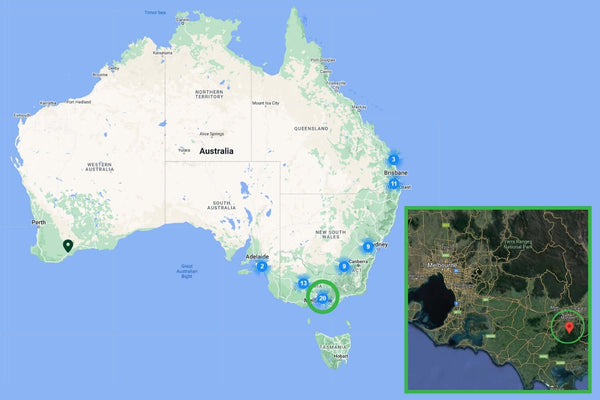Located on the lands of the Kurnai people in Gippsland, Victoria, the project at Jumbuk will see the restoration of native forest and habitat for a variety of local wildlife. It will provide habitat linkage with the Morwell National Park and Strzelecki State Forest to allow wildlife to move safely through the region.
Greenfleet first planted here in 2023 and will return to continue the reforestation work in 2024. This project will deliver climate action by removing carbon from the atmosphere, while helping bolster existing native ecosystems on the site. Many wildlife species will benefit from this project, including koalas.

Location & Map
Jumbuk is located in Gippsland, on the lands of the Kurnai people. It builds on Greenfleet’s extensive work in the Gippsland region.

Species Selection & Revegetation Approach
In 2023, Greenfleet restored 10 locally native species of trees and plants at Jumbuk. This includes Hop Goodenia (Goodenia ovata), Hazel Pomaderris (Pomaderris aspera) and silver Wattle (Bedfordia arborescens), which will provide habitat and food sources for a number of native bird, insect and marsupial species.
The seedlings were planted directly into the soil at Jumbuk and some species were guarded to alleviate browsing pressure. Once the trees are established and the risk from browsing has been reduced, the guards will be removed.

Wildlife Habitat Restoration
As planting operations began at Jumbuk, Greenfleet’s Revegetation Team observed koalas utilising the remnant trees on the property. By restoring eucalypt species, we are extending their habitat and food sources. Some of the species planted that will benefit koalas include Manna Gum (Eucalyptus viminalis) and Blue Gum (Eucalyptus globulus).
A Greenfleet forest called Wurneet Laang Laang is located about an hour east of Jumbuk. Part of the Strzelecki Nature Link, the forest at Wurneet Laang was planted in 2016 and had koalas return within just a few years of planting.
The forest at Jumbuk will also provide potential habitat for species including the White-throated Needletail, a bird classified as vulnerable in the state. Other species that will benefit from this revegetation work include the Long-nosed Bandicoot, Gang-gang Cockatoo, and the Greater Glider which is classified as endangered.
Greater Gliders have been heavily impacted by land clearing, resulting in their endangered status. Greenfleet has multiple revegetation projects underway that will provide habitat for this species as the forests become established. Marsupials such as gliders need hollow-forming trees, such as eucalypts, to establish long-term habitat. The forest at Jumbuk is legally protected so that ecological benefits like this can be delivered as the forest becomes established.
On a site monitoring visit after the 2023 planting, Rowan from Greenfleet’s Revegetation Team spotted an echidna in the revegetation area.

Climate Action
The forest growing at Jumbuk is legally protected for up to 100 years to deliver long-term climate action and environmental benefits. Over that time, it will capture over 5,200 tonnes of carbon from the atmosphere which is the equivalent to removing 1,214 average vehicles from Australia’s roads for a whole year.
Greenfleet uses the Full Carbon Account Model (FullCAM) to measure the carbon uptake at our revegetation sites. This model was developed by the CSIRO and is approved by the Department of Climate Change, Energy, the Environment and Water.
Location
2 hectares in Jumbuk, South-Eastern Victoria.
Planting Dates
2023
Species Planted
- Eucalyptus obliqua
- Eucalyptus cypellocarpa
- Eucalyptus viminalis
- Eucalyptus globulus
- Acacia melanoxylon
- Acacia dealbata
- Pomaderris aspera
- Bedfordia arborescens
- Acacia verticillata
- Goodenia ovata


